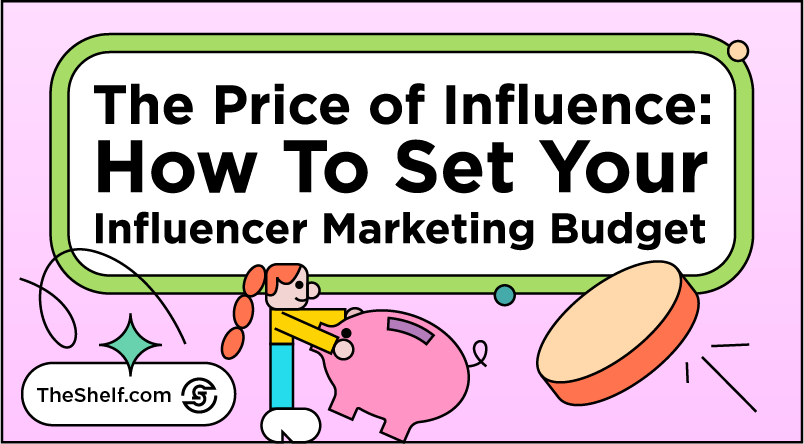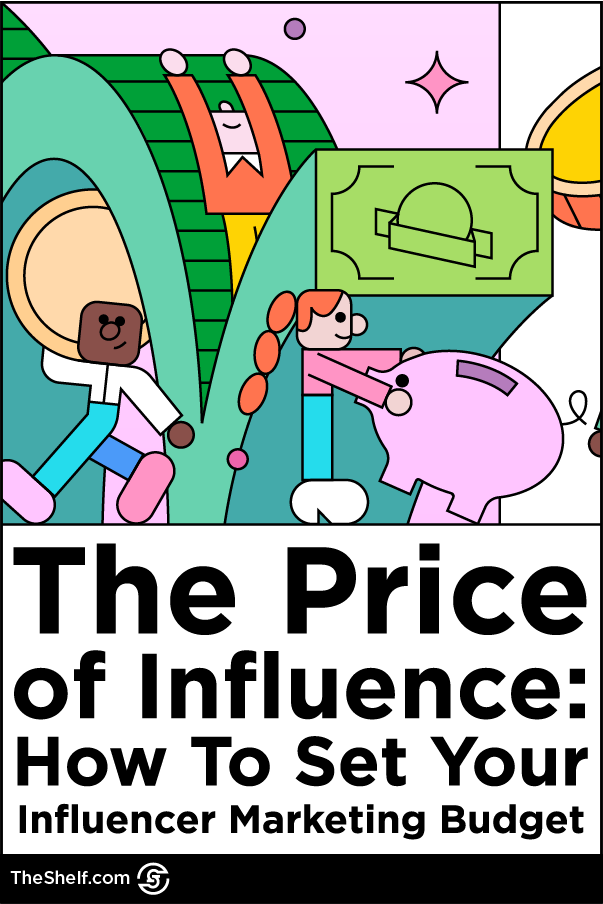I’ll just go ahead and say it: Influencers are national treasures. They’re the trendsetters we follow, the lifestyle gurus we admire, and the virtual friends we turn to for advice. From the fashion-forward Instagrammer who inspires our wardrobe choices, to the foodie YouTuber whose recipes never fail us, influencers have become an integral part of our daily lives. The time to set an influencer marketing budget for your brand was yesterday, but if you’ve been slacking, we get it, but today is the day.
Influencers have reshaped the world as a whole — especially the world of marketing. They’ve commanded global attention letting everyone know that influencer marketing isn’t just a trend. Beyond the value of influencer marketing, the total addressable market of the creator economy is expected to reach $480 billion by 2027, according to Goldman Sachs.
That means influencers and their influence are here to stay, and it impacts every brand. Their fresh, authentic approach to marketing has opened up new avenues for brands to connect with audiences in a way that traditional advertising never could.

Why an Influencer Marketing Budget is Crucial
Good news! According to Influencer Marketing Hub, about 62 percent of marketing firms have increased their influencer marketing budget this year, so if you’re reading this, you’re headed in the right direction! Choosing the right influencer for your campaign is important to the success of your campaign, and so is setting an appropriate budget. With careful planning and strategic thinking, it’s entirely achievable. Delicate balance? Sure, but we’re here to help you nail it.
Getting approval for an influencer marketing campaign and then setting your budget is about projecting the resources you need to achieve your marketing goals. Spend too much and you’re wasting resources that could pad your budget in other areas. Allocate too little and you likely won’t hit your campaign goals. Understanding this balance is everything.

Influencer marketing has evolved far beyond just likes and follows. Consumers are smart, and they expect brands to frontload value. To do so, you’re gonna have to make it a habit to leave no stone unturned. The complex dynamics of digital communities, assessing an influencer’s impact, and calculating the return on investment (ROI) are now the bare minimum. And the cornerstone of this process is a well-planned budget.
So…
This guide demystifies the process of setting an influencer marketing budget. We’ll explore its importance, discuss how much you should allocate, and break down where that money goes. Whether you’re a small business testing the waters of influencer marketing or a large enterprise aiming to optimize your campaigns, this guide will serve as your compass.
The Budget Blueprint
Did you know that for every $1 spent on influencer marketing, businesses are seeing an average return of $5.20? 🤑 Wild, right? It’s worth noting that this marketing goldmine is not without its pitfalls. The allure of high returns and massive engagement rates has led many brands astray, with investments pouring into ill-conceived campaigns with little to no return. That’s the danger of neglecting to set your influencer marketing budget in line with campaign goals.
As you build your campaign, think of your budget as the blueprint guiding its construction. Without it, your brand is vulnerable in every way. Doing the work to create a well-defined budget provides structure, helps you gauge the effectiveness of your campaigns, and prevents overspending.
Budgeting goes beyond the scope of setting spending limits. It should help you to make strategic decisions on where and how to invest your resources for the best possible return. Great budgeting is also about understanding the value of your brand’s culture, the potential reach of each campaign, and of course, the anticipated ROI.
Characteristics of the Influencer Marketing Landscape
Remember the middle-school science assignment where you had to create a self-sustaining ecosystem in a bottle? The creator economy is similar. It’s living, breathing, changing, growing, and ideally, self-sustaining.
The creator economy is a dynamic ecosystem, teeming with life, and evolution is constant. It’s a thriving biome where brands and influencers coexist, weaving experiences that can captivate millions of consumers.
Nano-Influencers
At the base of this ecosystem, nano-influencers, with their modest follower counts (less than 5,000), offer high engagement rates. They’re like the plants that form the foundation of a biome, cultivating loyal communities built on trust, and creating organic buzz.
Micro-Influencers
Micro-influencers, with a following between 5,000 to 50,000, are like the smaller fauna in our biome. They keep things going and create balance for the rest of the ecosystem (affordable reach and engagement) creating the most significant ROI.
Macro-Influencers
Macro-influencers have between 50,000 to 1 million followers. Maybe you put snails or earthworms in your biome. Think of them this way. They have extensive reach, come at a higher price, and can drive widespread awareness, or launch a new product.
Shout out to the teacher’s pets who put tadpoles or fish in their ecosystems. At the top of the ecosystem, mega-influencers, with follower counts over a million, are the apex species. These high-profile individuals often command a premium for their endorsement. While their reach is extensive they may lack intimacy or appear to be predatory in the eyes of the rest of the ecosystem.
The influencer marketing biome is diverse and requires a tailored approach and careful consideration of each component. Understanding the different influencer tiers, their unique offerings, and associated costs is crucial and will help you select the best influencers for your campaigns, maximize ROI, and stay within your budget.
6 Steps for Budgeting a Successful Influencer Campaign
There’s a ton to consider, so we won’t leave you hanging. You’re going to need strategic planning and foresight, an understanding of what you want to achieve with your campaign, and a careful consideration of potential challenges. So, let’s get going.
1. Define Your Marketing Goals
Is this a new product launch, a re-release, or are you expanding to a new market? Asking these questions will help you understand how to structure your budget. A campaign focused on boosting brand awareness might call for a larger budget for a wider reach, while a sales-driven campaign might require a more targeted approach and micro-influencers who can sway their niche audiences.
2. Determine Who You Want to Reach
Knowing who you’re targeting will help you to identify which would be the optimal platform to run your campaign. It also informs which type of influencer(s) you’ll need to partner with for your campaign.
3. Find the Right Creative Partners
More than just finding an influencer of the right size for your campaign, finding creative partners now really does mean finding creative, memorable ways to tie your brand to great content, far more than having an influencer talk up your brand. So, when it comes to finding the right creators to partner with, consider your campaign goals – are you focusing on brand awareness? Lean into larger influencers or interest graph creators who know how to make content that gets tons of plays, shares, and saves.
4. Determine Campaign Scale
Size matters. There. I said it! A larger campaign involving multiple influencers, diverse content types, and extended time frames is more taxing on your budget. On the flip side, smaller, focused campaigns with fewer influencers can be just as effective without turning your pockets out like bunny ears. Find the sweet spot that aligns with your goals and your target audience’s expectations.
5. Set Metrics for Success
Let me first say, a successful marketing budget accounts for the tools and resources required to track and analyze the performance of your campaign. Which metrics matter most? Decide on the metrics that matter most to you — impressions, clicks, conversions, or engagement — and invest in reliable tracking and analytics tools to measure these. Our influencer marketing platform A clear understanding of your ROI will help optimize future budget allocations.
6. Factor in Additional Costs
We’ve covered a few of the additional costs related to your budget, but that’s just the tip of the iceberg. There are creative costs — the production of content, editing, and design. There are potential agency fees, legal costs, and expenses for running and managing the campaign. Don’t forget to earmark a portion of your budget for these hidden costs. Consulting a professional marketing firm can eliminate the risk of costly oversights.
Tips for Optimizing Your Influencer Marketing Budget
Influencer marketing is a balancing act between ambition and practicality, innovation and effectiveness. Here are some strategies to help you make the most of your budget:
Leverage Micro-Influencers
Remember that micro-influencers keep the ecosystem going despite having smaller followings and often have higher engagement rates and a deeper connection with their audience. Collaborating with these niche influencers can yield a higher return on investment than pursuing big names with wide but less engaged followings. For instance, fitness apparel brand Gymshark successfully grew its audience by partnering with micro-influencers who genuinely connected with their product.
Have Long-Term #RelationshipGoals
Temporary partnerships can make temporary impressions, but long-term influencer relationships can offer sustained value and drive deeper engagement. Nothing in the world seems to stay the same. While your audience appreciates innovation, it loves consistency. A continuous narrative is often more engaging than one-off posts. I can’t imagine how Verizon customers must’ve felt when the “Can You Hear Me Now?” guy switched to Sprint. Sucks to be them!

Embrace User-Generated Content
93 percent of marketers agree that consumers trust UGC more than content created by brands. Encouraging influencers to generate their content gives you the best of both worlds: It saves on production costs and allows influencers to communicate their thoughts, ideas, and opinions in the most authentic way possible. Apple’s #shotoniphone campaign is the perfect example of this concept. Consumers LOVED it, and it was wildly successful.
Optimize and Recycle Content
94 percent of marketers repurpose content. Maximize the lifespan and impact of your influencer content, and your budget by repurposing it across different platforms and formats. Glossier’s content strategy often involves repackaging influencer-generated Instagram content for use in their email marketing campaigns or website, enhancing their overall marketing message.
Evaluate and Adapt
Closely monitor your campaign’s performance by measuring key metrics such as engagement rate, reach, conversions, and return on investment (ROI). Don’t be married to any methods. Always be willing to pivot and adjust your strategy based on these insights. Regular evaluation and adaptation will help you fine-tune your campaign, ensuring your influencer marketing efforts are both cost-effective and impactful.
Armed with these strategies, you can transform your influencer marketing budget from an expense sheet to a well-oiled machine driving your brand’s success. We’ve covered what helps your success. Now let’s look at the opposite end of the spectrum.
Major Pitfalls to Avoid When Planning an Influencer Marketing Budget
Influencer marketing can be complicated, and certain mistakes can destroy the effectiveness of your strategy. Identifying and understanding these common pitfalls can guide your brand toward a wildly successful campaign. Here’s a quick recap.
Misunderstanding the Influencer’s Audience
Remember the ecosystem. Don’t be swayed to partner with an influencer solely based on their follower count. Do your research. Be sure of an influencer’s audience demographics and engagement levels before finalizing a partnership. The focus should be on quality, not just quantity.
Neglecting to Set Clear Goals and KPIs
Your budget is more than just a number; it’s a tool to achieve your objectives. If you set a budget without clear, quantifiable goals, the outcome is an ineffective strategy. Explicitly define your targets, and use key performance indicators (KPIs) to monitor progress. Having clear goals is a must.
Overlooking Additional Costs
Keep this front of mind: Influencer marketing budgets often have hidden expenses. Ensure you account for additional costs such as content creation, management fees, and campaign monitoring tools. These unseen costs can kill your budget if they aren’t considered.
Undervaluing Micro-Influencers
It’s natural to want to work with the biggest names you can afford. While top-tier influencers may seem attractive initially, dive a little deeper. Remember that micro-influencers may be a better option for your brand. They often provide a highly engaged audience and cost-effective partnership opportunities, offering a substantial return on investment for your brand.
Forecasting Influencer Marketing Budgets for 2024
Influencer marketing has grown exponentially year over year. Expect huge things for 2024. Its valuation has soared from 9.7 billion dollars in 2020 to 15.2 billion U.S. dollars in 2022, and its global market size will reach 22.2 billion U.S. dollars by 2025.
Expect to see a continued rise in the value of micro- and nano-influencers. Micro-influencers can generate up to a 60 percent higher engagement rate compared to macro-influencers. Their authenticity and intimate connection with their target audience will continue to yield impressive ROI, and budgeting for partnerships with these influencers will be increasingly important.
The rapid adoption of new social media platforms is the new normal. Meta’s Threads, which saw 30 million downloads in less than a day, indicates a shifting landscape. Brands will need to stay agile, adapting their strategies and budgets to leverage these emerging platforms and reach their audiences effectively.
The importance of video content and live streaming in influencer marketing is also on the rise. Platforms like TikTok are enhancing real-time, authentic engagement with features like TikTok LIVE and LIVE Subscription. These features not only boost creators’ earnings but also deepen community ties with exclusive content and interactions.
Stepping into 2024, the influencer marketing landscape may look different, but with the right budget and a dash of foresight, your brand can run campaigns that dominate the market.
Next Steps
And there you have it, my marketing mavens! We’ve journeyed through the ins and outs of influencer marketing budgeting together. Remember, your budget isn’t just about numbers — it’s the strategic compass that directs your brand toward successful campaigns, meaningful partnerships, and ultimately, your marketing goals.
Ready to take the next step? We’re here to help! Book a strategy session with the mega geniuses here at The Shelf. Together, we can navigate the exciting landscape of influencer marketing and chart a course for your brand’s success.

ABOUT THE AUTHOR
Lira Stone | Effective, Magnetic Strategist
For over a decade, my focus has been ensuring that professionals stay ahead of the curve in the most time-efficient, task-prioritized, and stress-free manner possible. My extensive experience has equipped me with the knowledge to design a concise, company-culture-relevant, methodical approach to internet sales and marketing.







